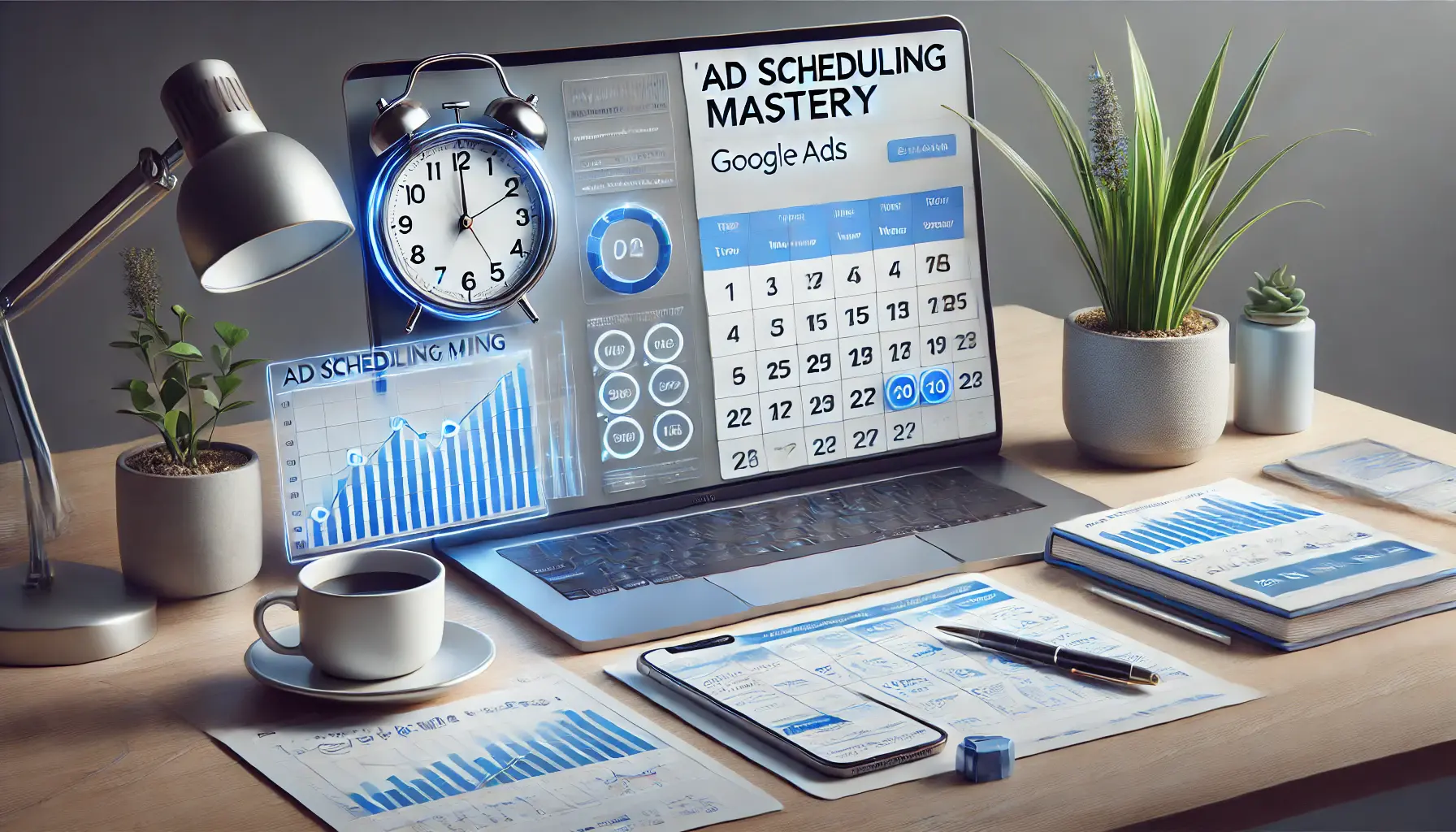Google Ads revolutionized the way businesses communicate with their target audience, offering several ad types to support driving conversions and traffic.
Among these, one of the most innovative tools is Dynamic Search AdsA type of ad in Google Ads that automatically creates ads based on your website content. (DSAs), a type of ad where advertisers can have automatically generated ads based on their website content.
If you’ve ever felt the pain of maintaining extensive keyword lists or losing out on potential traffic due to keyword gaps, Dynamic Search Ads could be your solution.
Below, we explore how to master Dynamic Search Ads setup and advanced strategies to optimize your campaigns effectively.
Dynamic Search Ads are a powerful tool for any business looking to increase visibility without relying entirely on keyword-targeted ads.
Instead of pre-defining keywords, DSAs dynamically build ads by crawling your website for relevant content.
This enables advertisers to capture traffic from search queries they may not have initially targeted using traditional search campaigns.
Let’s dive into what Dynamic Search Ads are and how they work in Google Ads.
- What Are Dynamic Search Ads and How Do They Work?
- How to Set Up Dynamic Search Ads: A Step-by-Step Process
- Optimizing Dynamic Search Ads for Premier Performance
- Common Dynamic Search Ads Challenges and Solutions
- Advanced Tips to Master Dynamic Search Ads
- Maximizing Success with Dynamic Search Ads
- Frequently Asked Questions About Dynamic Search Ads
What Are Dynamic Search Ads and How Do They Work?
Dynamic Search Ads offer a different approach from the usual keyword-centric campaigns.
By using the content of your website, DSAs automatically match your pages to relevant search queries.
This automation streamlines the process, saving time while allowing you to tap into new search terms that might have been overlooked.

Dynamic Search Ads automate ad creation based on website content, driving more efficient ad campaigns.
Introduction to Dynamic Search Ads
Dynamic Search Ads are designed to automatically generate headlines based on the most relevant pages of your website.
Rather than manually setting specific keywords, Google scans your site’s content and matches it to related search terms.
It dynamically generates the ad headline, ensuring it aligns with what users are searching for, while your pre-set description remains constant.
For example, if your website sells hiking boots and someone searches for ‘best waterproof hiking boots,’ Google could show an ad that directs users to your specific product page for waterproof hiking boots—even though you didn’t specifically target that keyword.
- Automation: Google creates ads from the most relevant page content.
- Headline Generation: Dynamic headlines reflect the user’s search query, boosting relevancy.
- Improved Reach: DSAs capture traffic that could be missed in traditional keyword targeting.

Dynamic Search Ads are generated automatically by scanning website content and matching it with relevant search queries.
How Dynamic Search Ads Are Generated
The power of Dynamic Search Ads lies in automation and AI.
Once you create a DSA campaign, Google’s algorithm continuously crawls your website to select the most relevant landing pages that match specific search queries.
When a user searches a term that matches your website content, Google dynamically generates an ad with a headline based on the query and directs the user to the most suitable landing page.
Although the headlines are dynamically generated, the descriptions remain static.
This means that while Google personalizes the headline for each search, the description stays the same across all ads in the campaign.
This balance allows for personalized advertising while maintaining control over the message across different ad variations.
- Google continuously scans your website content.
- Headlines are dynamically generated based on relevant search queries.
- Descriptions provided by you remain constant across all ads.

Dynamic Search Ads provide expanded reach, time-saving automation, and enhanced relevancy in digital marketing campaigns.
Key Benefits of Using Dynamic Search Ads
One of the biggest benefits of using Dynamic Search Ads is the ability to capture search traffic for terms you may not have anticipated.
This can significantly boost your ad reach and help you discover valuable keywords for future campaigns.
Additionally, DSAs save time by reducing the need for constant keyword research and updates, making them especially useful for businesses with large websites or frequently changing product inventories.
- Expanded Reach: Capture more traffic from relevant searches you may not have initially thought to target.
- Time-Saving: Reduce manual keyword management and let Google’s algorithm handle ad targeting.
- Enhanced Relevancy: Dynamic headlines match user search intent, leading to higher click-through rates (CTR).
Dynamic Search Ads help businesses save time by automating ad creation and matching search queries with website content.

Setting up Dynamic Search Ads involves a step-by-step process, from campaign creation to ad automation.
How to Set Up Dynamic Search Ads: A Step-by-Step Process
At first glance, the process of setting up Dynamic Search Ads can seem intimidating, but with the right steps, you can build and manage a successful campaign that captures better traffic.
Dynamic Search Ads rely heavily on the structure and relevance of your website.
This means that the more organized and relevant your content is, the better your DSAs will perform.
Below, we’ll walk you through the key steps to setting up Dynamic Search Ads, ensuring you can fully take advantage of this feature within Google Ads.

The first step in creating Dynamic Search Ads involves setting up a new campaign with automated tools for website scanning.
Step 1: Creating a New Campaign for Dynamic Search Ads
Start by creating a new campaign in your Google Ads account for DSAs.
When creating the campaign, select the ‘Search’ campaign type and choose your objective—whether it’s driving sales, leads, or website traffic.
- Sign in to your Google Ads account and click on ‘New Campaign’.
- Select the campaign goal that matches your business objectives, such as ‘Sales’ or ‘Website Traffic’.
- Choose the ‘Search Network’ as the campaign type.
- Under the ‘Dynamic Search Ads’ section, enter your website’s domain. Google will crawl content on this domain to create dynamic ads. Ensure your website is fully optimized with well-structured content for maximum DSA performance. The richer and more comprehensive your content, the greater the chance of Dynamic Search Ads helping you capture a wide range of search queries.

Dynamic ad targets and precise targeting options help refine the reach of ads based on relevant content and categories.
Targeting Options and Dynamic Ad Targets
One of the most valuable features of Dynamic Search Ads is the ability to set specific targeting options through dynamic ad targets.
These allow you to narrow down the categories or pages of your website where ads should appear, ensuring your ads only show for the most relevant content.
Dynamic ad targets are crucial for keeping your DSAs aligned with your business goals.
There are three main types of dynamic ad targets to consider:
- Categories: Google organizes your website’s content into categories based on your offerings. This allows you to target your ads to specific groups of pages, such as ‘Women’s Shoes’ or ‘Laptop Accessories’.
- URL Contains: You can set ads to trigger when specific URLs contain certain keywords. For example, you can target all URLs containing ‘shoes’ or ‘electronics’.
- All Webpages: You can target all pages on your website for maximum reach, but this requires careful management to ensure relevance.
By selecting the right dynamic ad targets, you ensure that Dynamic Search Ads are served only when the content of your website directly matches what users are searching for.
This improves ad relevance and leads to better engagement from potential customers.

Effective bidding and budgeting strategies ensure balance and optimization in digital marketing campaigns.
Best Practices for Bidding and Budgeting
Just like with any Google Ads campaign, managing your bidding and budgeting is essential for achieving the best results with Dynamic Search Ads.
Here are some tips to help you make the most of your advertising budget:
- Begin with Manual CPC Bidding: When starting a DSA campaign, it’s advisable to begin with manual cost-per-click (CPC) bidding to control your ad spend and track performance. Once you gather enough data, you can switch to automated bidding strategies like Target CPA or Target ROAS.
- Utilize Negative Keywords: Negative keywords refine your campaign by excluding irrelevant search terms. By adding negative keywords, you prevent your DSAs from showing ads for irrelevant queries, saving money and improving overall performance.
- Set a Realistic Daily Budget: Set a daily budget that aligns with your overall marketing goals. It’s recommended to start small and gradually increase your budget as you see positive results from your DSA campaign.
- Monitor and Adjust Bids Regularly: Monitor your campaign frequently to ensure your bids are competitive. Use bid adjustments based on devices, locations, or specific ad targets to optimize performance.
By following these steps and best practices, you’ll be well on your way to creating a highly successful Dynamic Search Ads campaign that drives valuable traffic to your website.
Ensure your website is optimized with well-structured content for the best Dynamic Search Ads performance.

Optimizing Dynamic Search Ads ensures premier performance through data-driven strategies and precision targeting.
Optimizing Dynamic Search Ads for Premier Performance
After setting up your Dynamic Search Ads campaign, the second most important step is optimization.
By optimizing DSAs, you ensure that you get the most out of your ad spend by reaching the most relevant audience.
Without proper optimization, you may miss valuable traffic.
Here’s how to optimize your Dynamic Search Ads for maximum performance on Google Ads.

Customizing dynamic headlines and descriptions allows for personalized and optimized ad content in digital campaigns.
Customization of Dynamic Headlines and Descriptions
The headline is often the most important part of any ad, and this is especially true for Dynamic Search Ads.
Since the headline is dynamically generated by Google based on the user’s query, you should ensure that your site’s content is highly relevant to the products or services you advertise.
To further optimize DSA performance:
- Ensure the metadata on your website—title tags and descriptions—is optimized with relevant keywords. This helps Google automatically create more accurate headlines that match search intent.
- While you can’t control the headline, you can optimize the ad description. Write a concise yet compelling ad description that communicates your unique selling points (USPs). Include keywords that align with your offerings.
- Use calls to action in your descriptions like ‘Shop Now,’ ‘Learn More,’ or ‘Get a Quote.’ This will drive user interaction and improve your click-through rates (CTR).
One major aspect of DSA optimization is writing compelling dynamic headlines and refining ad descriptions to achieve maximum user engagement, ensuring your ad stands out in a competitive search landscape.

Improving landing page relevance ensures higher ad performance by connecting user queries to the most relevant web pages.
Improving Landing Page Relevance
Your landing page is one of the most important components of Dynamic Search Ads.
Since DSAs automatically direct users to relevant landing pages, it’s essential to ensure that these pages are optimized for both user experience and relevance to the search query.
To improve landing page relevance:
- Ensure the content on your landing pages matches the intent behind the search query. This increases your ad’s relevancy score and improves your quality scores, potentially lowering your cost-per-click (CPC).
- Optimize landing pages for mobile devices. With more users browsing and buying via mobile, a mobile-friendly landing page ensures a smooth user experience.
- Maintain fast loading speeds on your landing pages. Google considers page load time when ranking ads, so optimizing for speed can improve ad rankings and user satisfaction.
By aligning your landing page content with the queries targeted by DSAs, you can increase conversion rates and reduce bounce rates.
Tracking and analyzing Dynamic Search Ad performance involves monitoring key metrics like click-through and conversion rates to optimize campaigns.
Tracking and Analyzing Dynamic Search Ad Performance
Once your Dynamic Search Ads are live, tracking their performance is essential to ensure you’re meeting your campaign goals.
Google Ads provides various tools to help you analyze how well your DSAs are performing.
Here are some key metrics to track:
- Click-Through Rate (CTR): A high CTR indicates that your ad is relevant to the search queries it targets. If your CTR is low, refine your descriptions or optimize your landing pages.
- Conversion Rate: This measures how many users who clicked on your ad completed a desired action, such as making a purchase or signing up for a newsletter. Low conversion rates may signal a disconnect between your ad and its landing page.
- Quality Score: Google assigns a quality score to your ads based on relevance, landing page experience, and expected CTR. A higher quality score often leads to lower costs and better ad positioning.
- Cost Per Click (CPC): Monitoring CPC ensures that your campaign remains cost-effective. Over time, optimizing your keywords and negative keywords can help reduce your CPC.
By closely monitoring these metrics, you’ll be able to make informed decisions about adjusting your Dynamic Search Ads campaign for better performance.

Effectively using negative keywords helps refine ad campaigns by excluding irrelevant or unhelpful search terms.
Using Negative Keywords Effectively
Negative keywords are essential for ensuring that your ads don’t show up for irrelevant queries.
By adding negative keywords, you filter out searches that are unlikely to result in conversions, saving money and improving your campaign’s performance.
Here are some tips on using negative keywords effectively:
- Start by reviewing your search term report in Google Ads to identify irrelevant queries that triggered your ads. Add these as negative keywords to prevent them from showing in the future.
- Consider using broad match negative keywords to exclude large groups of irrelevant searches. For example, if you sell high-end shoes, you may want to exclude terms like ‘cheap shoes’ or ‘free shoes.’
- Regularly update your negative keyword list as more data becomes available. This ensures that your ads remain targeted and relevant.
Applying negative keywords is another critical step in refining your Dynamic Search Ads strategy, ensuring your ads are shown only to users with genuine interest in your product or service.
Optimizing Dynamic Search Ads is an ongoing process.
With regular adjustments and attention to detail, you’ll see improvements in performance, more conversions, and better ad budget utilization.
Regular optimization of dynamic headlines and descriptions will help ensure high user engagement and better ad performance.

Common challenges in Dynamic Search Ads are met with strategic solutions, ensuring ad campaigns overcome obstacles and achieve optimization.
Common Dynamic Search Ads Challenges and Solutions
With Dynamic Search Ads, you can capture traffic effectively without relying on large keyword lists, but they are not without their challenges.
For your Dynamic Search Ads campaign to perform optimally, it is important to recognize these common issues and know how to overcome them.
Below are some of the most frequently encountered challenges with DSAs and how you can solve them.

Overcoming irrelevant traffic ensures that ads target the right audience and improve campaign efficiency.
Overcoming Issues with Irrelevant Traffic
One of the most common problems with Dynamic Search Ads is attracting irrelevant traffic.
Since DSAs rely on Google’s algorithm for matching your site content with search queries, there’s a chance that ads may show for terms that are not precisely relevant to your business.
Here’s how to address this issue:
- Apply Negative Keywords: Regularly review your search term report to identify irrelevant queries that triggered your ads. Add these queries as negative keywords to avoid serving ads for these terms in the future.
- Refine Dynamic Ad Targets: Instead of targeting all pages of your website, refine your dynamic ad targeting to specific categories or URLs. This will give you better control over matching content with search queries.
- Optimize Website Content: Ensure that your website content is highly relevant and organized around the products or services you promote. This will help Google’s algorithm better understand which search queries are appropriate for your ads.

Effectively managing ad group complexity helps streamline and optimize digital advertising campaigns.
Managing Ad Group Complexity
As your Dynamic Search Ads campaign grows, it can become difficult to manage multiple ad groups and campaigns effectively.
DSAs allow for broad targeting, but if not managed carefully, it can lead to confusion and a lack of control.
Here’s how to manage ad group complexity:
- Group Related Pages Together: Organize your ad groups by related products, services, or categories. For example, in an e-commerce store, you could create separate ad groups for product lines like ‘Men’s Shoes’ or ‘Women’s Accessories.’
- Use Clear Naming Conventions: When creating new ad groups, use clear and descriptive names so you can easily identify what each ad group targets. This will make managing and optimizing multiple ad groups much easier over time.
- Monitor Performance by Ad Group: Regularly review the performance of each ad group. Pause or adjust underperforming ad groups to allocate more budget to those performing well.

Handling poor ad performance involves identifying issues and applying optimization techniques to improve results.
Handling Poor Ad Performance
Poor ad performance can be frustrating when investing in a Dynamic Search Ads campaign.
Issues such as low click-through rates (CTR), high cost-per-click (CPCCost-per-click, the amount you pay for each click on your ad.), or no conversions are common problems.
Here’s how to improve poor ad performance:
- Refine Your Ad Descriptions: Ad descriptions play a critical role in encouraging users to click. Ensure your descriptions are clear, concise, and highlight your unique selling points (USPs). Include persuasive calls to action like ‘Buy Now’ or ‘Get a Free Quote’ to boost CTR.
- Improve Landing Page Experience: Ensure your landing pages are relevant to the user’s query, easy to navigate, and fast to load. A positive landing page experience can improve quality scores and reduce CPC over time.
- Analyze Search Term Reports: Continuously review your search term reports to identify which queries are performing well and which are not. Use this data to refine your targeting and negative keywords.

Avoiding landing page mismatches ensures that users are directed to the most relevant content, improving ad performance.
Avoiding Landing Page Mismatches
Sometimes Google’s algorithm directs users to pages that don’t exactly match their search intent, leading to a poor user experience and increased bounce rates.
Here’s how to avoid landing page mismatches:
- Use Specific Dynamic Ad Targets: Instead of targeting all webpages, set dynamic ad targets for specific URLs or categories that are highly relevant to the user’s search intent. This will guide users to the right landing page.
- Optimize Landing Page Content: Make sure each landing page is highly relevant to the search queries that drive traffic to it. Enhance page relevance by including relevant keywords, headings, and calls to action, which can help reduce bounce rates.
- Test and Optimize: A/B testing various landing pages for the same query can help determine which page performs best. Use this data to route users to the highest-converting landing pages.
By addressing these common challenges, Dynamic Search Ads will help ensure your campaigns are performing at their best, allowing you to get the most out of your ad spend.
One common challenge is attracting irrelevant traffic. Using negative keywords and refining dynamic ad targets can solve this.

Mastering Dynamic Search Ads involves advanced strategies like optimization, data analysis, and precise targeting.
Advanced Tips to Master Dynamic Search Ads
Once you have set up and optimized your Dynamic Search Ads campaign, a number of advanced strategies can be implemented to take it to the next level.
These will help you capture more relevant traffic, maximize your return on investment (ROI), and streamline the ad management process.
Let’s explore some of the most effective advanced strategies for mastering Dynamic Search Ads in Google Ads.

Leveraging Dynamic Search Ads helps capture long-tail keywords, improving ad precision and relevancy in search marketing.
Leveraging Dynamic Search Ads for Long-Tail Keywords
Dynamic Search Ads are particularly powerful for capturing long-tail keywords that may not be covered in traditional campaigns.
Long-tail keywords are often highly specific phrases that are less competitive and, therefore, cheaper.
These keywords can drive more qualified leads since they often carry more purchase intent.
Here’s how you can use DSAs to unlock long-tail keywords:
- Use Targeted Categories: Narrow down your Dynamic Search Ads to specific categories or product pages. This helps you capture long-tail searches that match your most relevant offerings.
- Optimize Content for Long-Tail Search: Ensure your website content includes long-tail keywords related to your products or services. This helps Google’s algorithm match your pages more effectively with long-tail queries.
- Review Search Term Reports: Regularly review your search term reports to find which long-tail keywords are driving conversions. Use this data to further optimize your campaign and add high-performing long-tail keywords to your manual campaigns.

Leveraging Dynamic Search Ads helps capture long-tail keywords, improving ad precision and relevancy in search marketing.
Using Dynamic Search Ads in Conjunction with Other Campaigns on Google Ads
Dynamic Search Ads work even better when combined with other types of campaigns on Google Ads.
By integrating DSAs with manual search campaigns, remarketing, or shopping campaigns, you can cover more ground and ensure that your ads are served at every stage of the customer journey.
Here’s how to effectively integrate DSAs with other campaigns:
- Capture Missed Traffic Using DSAs: Use Dynamic Search Ads to capture traffic from search queries that may not be covered by your traditional keyword campaigns. This helps ensure that keyword gaps aren’t causing you to lose potential leads.
- Combine DSAs with Remarketing: Pair DSAs with remarketing lists for search ads (RLSA) to re-engage users who have previously visited your website. This increases the likelihood of conversion by showing relevant ads to users already familiar with your brand.
- Integrate with Shopping Campaigns: For e-commerce businesses, integrating DSAs with shopping campaigns can drive traffic to product pages that aren’t being targeted by your shopping ads. This extends your visibility and boosts sales across your entire product catalog.

Smart Bidding with Dynamic Search Ads automates bid adjustments for optimal ad performance and efficiency.
Using Dynamic Search Ads with Smart Bidding
Smart Bidding strategies use machine learning to optimize your bids in real-time, helping you get the best results from your campaigns.
Paired with Dynamic Search Ads, Smart BiddingA set of automated bid strategies that use machine learning to optimize for conversions or conversion value. can help you achieve your goals more efficiently, whether it’s to maximize conversions, hit your desired cost-per-acquisition (CPACost-per-acquisition, a bidding strategy focused on the cost of acquiring a customer.), or increase return on ad spend (ROASReturn on ad spend, a metric that measures the revenue generated for every dollar spent on advertising.).
Here’s how to use Smart Bidding with DSAs:
- Maximize Conversions: Use this bidding strategy to automatically adjust your bids and gain more conversions from Dynamic Search Ads. This works well for businesses that want to drive more sales or leads.
- Target CPA: If you have a specific CPA goal, use the Target CPA bidding strategy. Google will automatically set bids to get as many conversions as possible within your desired CPA.
- Target ROAS: For businesses aiming to maximize their return on ad spend, use the Target ROAS bidding strategy. This strategy helps you set bids that maximize revenue while staying within your target ROAS.

Dynamic Search Ads provide automated ad generation, while Traditional Search Ads offer manual control and keyword targeting.
Dynamic Search Ads vs. Traditional Search Ads: When to Use Each
While both Dynamic Search Ads and traditional search ads have their place in a comprehensive Google Ads strategy, knowing when to use each can significantly improve your results.
DSAs are ideal for capturing traffic from broad or long-tail queries, while traditional search ads are better for targeting high-intent keywords.
Here’s when to use DSAs versus traditional search ads:
- Use DSAs When: You have a large website with many pages, frequently updated content, or a wide range of products. DSAs are effective for covering keyword gaps and capturing traffic from broad, long-tail queries.
- Use Traditional Search Ads When: You want more control over your ad copy, keywords, and targeting. Traditional search ads are better for targeting high-intent keywords with specific messaging.
- Combine Both Strategies: Use a combination of DSAs and traditional search ads to ensure all bases are covered. DSAs can help you capture missed traffic, while traditional search ads can drive conversions for high-intent queries.
By applying these advanced strategies to your Dynamic Search Ads campaigns, you’ll be able to get the best from your performance, capture more qualified leads, and achieve better results from your ad spend.
Leveraging long-tail keywords and using Smart Bidding are advanced strategies that can boost Dynamic Search Ads performance.

Maximizing success with Dynamic Search Ads involves optimizing strategies to drive growth and performance in digital marketing.
Maximizing Success with Dynamic Search Ads
Mastering the use of Dynamic Search Ads on Google Ads can significantly enhance your advertising performance by better capturing relevant traffic and improving returns on investment.
This guide has shown how DSAs can automate the ad creation process and optimize campaigns for higher conversions by dynamically matching ads to user queries.
With a solid understanding of DSAs, you can expect significant growth in your advertising efforts.

Dynamic Search Ads are a game-changer due to their automation, increased reach, and innovation in digital marketing.
Why Dynamic Search Ads Are a Game-Changer
Dynamic Search Ads are an innovative way to reach more audiences without the manual workload required by traditional search ads.
DSAs rely on Google to dynamically build ads based on user searches by leveraging the content of your website.
This approach saves time and captures traffic that might otherwise be missed.
The biggest advantage is that you can cover a broad range of search terms while maintaining relevance to your audience.

Optimizing Dynamic Search Ads for long-term success requires continuous improvement and strategic growth.
Optimizing Your Dynamic Search Ads for Long-Term Success
Unlocking the full potential of Dynamic Search Ads requires ongoing optimization.
Whether it’s customizing headlines and descriptions, refining landing pages, or tracking key performance metrics like CTR and CPC, optimization ensures you get the most value out of your ad spend.
Adding negative keywords, refining dynamic ad targets, and aligning your content with search intent are crucial steps in maximizing your ads’ performance.

Advanced strategies help elevate digital marketing campaigns by using data-driven insights and optimization techniques.
Advanced Strategies to Elevate Your Campaign
Once your campaign is established, advanced strategies like leveraging long-tail keywords and integrating Dynamic Search Ads with other Google Ads campaigns can take performance to the next level.
Pairing DSAs with Smart Bidding helps you achieve your specific goals, whether that means maximizing conversions or improving ROAS.
Integrating DSAs with remarketing or shopping campaigns further expands your reach and ensures that your ads continuously engage potential customers throughout their buying journey.

Dynamic Search Ads provide automation, while Traditional Search Ads offer manual control and keyword targeting, each serving different ad strategies.
Dynamic Search Ads vs. Traditional Search Ads: When to Use Each
While Dynamic Search Ads are excellent at capturing long-tail keywords and filling in gaps missed by manual campaigns, traditional search ads offer greater control over ad copy and targeting.
Using both in conjunction covers all bases, from broad to highly specific queries, maximizing your results.

Maximizing Dynamic Search Ads requires continuous refinement and optimization to drive growth and success in digital marketing.
Final Thoughts on Maximizing Dynamic Search Ads
As you continue to refine your Dynamic Search Ads campaigns, remember that success depends on ongoing optimization and a deep understanding of advanced features that can drive performance.
Whether you adjust bidding strategies, refine ad groups, or optimize landing pages, each step plays a critical role in the bigger picture.
With the right strategies and constant refinements, DSAs will not only help you reach new audiences but also deliver high-quality leads that convert.
By applying the lessons from this guide, you can ensure that your Dynamic Search Ads campaigns are aligned with your business objectives and that your ad spend yields measurable results.
Ongoing optimization and tracking key metrics are crucial for maximizing success with Dynamic Search Ads.

Addressing frequently asked questions about Dynamic Search Ads helps clarify key concepts in digital marketing strategies.
Your campaigns can be managed by an agency specialized in Google Ads, check out our service page.
Frequently Asked Questions About Dynamic Search Ads
Below are some of the frequently asked questions related to Dynamic Search Ads in Google Ads.
These answers will help you better understand how DSAs work and how to maximize their performance.
Dynamic Search Ads automatically create ads by matching user search queries to relevant content on your website, without requiring manual keyword targeting.
Google automatically generates headlines for Dynamic Search Ads based on the content of your website, matching it with user search queries.
Dynamic Search Ads save time, capture traffic from missed search queries, and cover a broader range of search terms you may not have considered manually.
Unlike traditional search ads, which rely on manual keyword targeting, Dynamic Search Ads automatically match your website content with user searches, removing the need for keyword lists.
To optimize your Dynamic Search Ads, customize ad descriptions, improve landing page relevance, add negative keywords, and monitor performance metrics like CTR and conversions.
Yes, you can combine Dynamic Search Ads with traditional search campaigns to cover keyword gaps and capture more traffic while maintaining control over specified keywords in manual campaigns.
Businesses with large websites, frequent updates, or extensive product catalogs benefit the most from Dynamic Search Ads because they can capture a wider range of search queries without manual effort.
Smart Bidding uses machine learning to optimize your Dynamic Search Ads by adjusting bids in real-time to achieve goals like maximizing conversions or increasing ROAS.
To limit irrelevant traffic in Dynamic Search Ads, add negative keywords, refine dynamic ad targets, and regularly review search term reports to identify and exclude irrelevant queries.














